Different Effects of Riociguat and Vericiguat on Pulmonary Vessels and Airways
Abstract
1. Introduction
2. Materials and Methods
3. Results
3.1. Precision Cut Lug Slices
3.1.1. Pulmonary Arteries and Veins
3.1.2. Airways
3.2. Isolated Lung Perfusion
3.2.1. Pulmonary Artery Pressure
3.2.2. Airway Resistance
3.2.3. Wet/Dry Ratio
3.2.4. Cytokines and Chemokines
4. Discussion
5. Conclusions
Supplementary Materials
Author Contributions
Funding
Institutional Review Board Statement
Data Availability Statement
Acknowledgments
Conflicts of Interest
Abbreviations
| ARDS | Acute respiratory distress syndrome |
| cGMP | Cyclic guanosine monophosphate |
| COPD | Chronic obstructive pulmonary disease |
| CRP | C-reactive protein |
| CTEPH | Chronic thromboembolic pulmonary hypertension |
| CXCL1 | Chemokine (C-X-C motif) ligand 1 |
| DMSO | Dimethyl sulfoxide |
| eNOS | Endothelial nitric oxide synthase |
| IAA | Initial airway area |
| IFNγ | Interferon γ |
| IL-10 | Interleukin-10 |
| IL-13 | Interleukin-13 |
| IL-4 | Interleukin-4 |
| IL-5 | Interleukin-5 |
| IL-1ß | Interleukin-1ß |
| IL-8 | Interleukin-8 |
| IL-6 | Interleukin-6 |
| IPL | Isolated lung perfusion |
| IVA | Initial vessel area |
| PVR | Pulmonal vascular resistance |
| KC-GRO | Keratinocyte chemoattractant/human growth-regulated oncogene |
| MCP-1 | Monocyte chemoattractant protein-1 |
| NO | Nitric oxide |
| PAH | Pulmonary arterial hypertension |
| PAP | Pulmonary artery hypertension |
| PCLS | Precision Cut Lung Slices |
| PH | Pulmonary Hypertension |
| PKG | Protein Kinase G |
| Rio | Riociguat |
| SEM | Standard error of the mean |
| sGC | Soluble guanylate cyclase |
| TNFα | Tumor necrosis factor α |
| VEGF-A | Vascular endothelial growth factor A |
| Ver | Vericiguat |
Appendix A
Appendix A.1

Appendix A.2
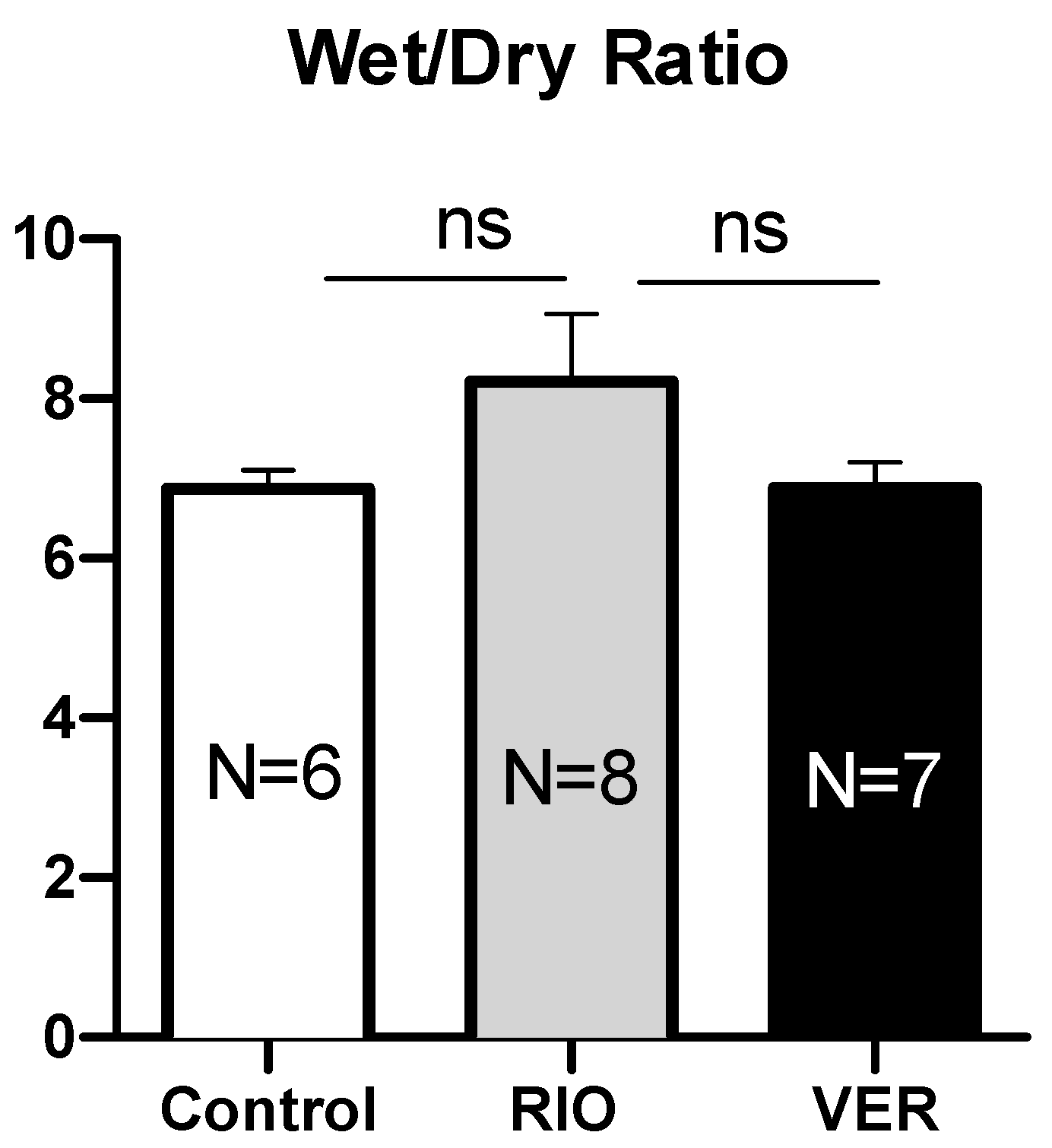
References
- Ruopp, N.F.; Cockrill, B.A. Diagnosis and Treatment of Pulmonary Arterial Hypertension: A Review. JAMA 2022, 327, 1379–1391. [Google Scholar] [CrossRef] [PubMed]
- Xu, W.J.; Wu, Q.; He, W.N.; Wang, S.; Zhao, Y.L.; Huang, J.X.; Yan, X.S.; Jiang, R. Interleukin-6 and pulmonary hypertension: From physiopathology to therapy. Front. Immunol. 2023, 14, 1181987. [Google Scholar] [CrossRef]
- Willems, L.; Kurakula, K.; Verhaegen, J.; Klok, F.A.; Delcroix, M.; Goumans, M.J.; Quarck, R. Angiogenesis in Chronic Thromboembolic Pulmonary Hypertension: A Janus-Faced Player? Arterioscler. Thromb. Vasc. Biol. 2024, 44, 794–806. [Google Scholar] [CrossRef] [PubMed]
- Soon, E.; Holmes, A.M.; Treacy, C.M.; Doughty, N.J.; Southgate, L.; Machado, R.D.; Trembath, R.C.; Jennings, S.; Barker, L.; Nicklin, P.; et al. Elevated levels of inflammatory cytokines predict survival in idiopathic and familial pulmonary arterial hypertension. Circulation 2010, 122, 920–927. [Google Scholar] [CrossRef]
- Groth, A.; Vrugt, B.; Brock, M.; Speich, R.; Ulrich, S.; Huber, L.C. Inflammatory cytokines in pulmonary hypertension. Respir. Res. 2014, 15, 47. [Google Scholar] [CrossRef]
- Yoo, H.H.B.; Marin, F.L. Treating Inflammation Associated with Pulmonary Hypertension: An Overview of the Literature. Int. J. Gen. Med. 2022, 15, 1075–1083. [Google Scholar] [CrossRef]
- Magon, W.; Stepniewski, J.; Waligora, M.; Jonas, K.; Przybylski, R.; Podolec, P.; Kopec, G. Changes in Inflammatory Markers in Patients with Chronic Thromboembolic Pulmonary Hypertension Treated with Balloon Pulmonary Angioplasty. Cells 2022, 11, 1491. [Google Scholar] [CrossRef]
- Morbidelli, L.; Pyriochou, A.; Filippi, S.; Vasileiadis, I.; Roussos, C.; Zhou, Z.; Loutrari, H.; Waltenberger, J.; Stossel, A.; Giannis, A.; et al. The soluble guanylyl cyclase inhibitor NS-2028 reduces vascular endothelial growth factor-induced angiogenesis and permeability. Am. J. Physiol. Regul. Integr. Comp. Physiol. 2010, 298, R824–R832. [Google Scholar] [CrossRef]
- Koika, V.; Zhou, Z.; Vasileiadis, I.; Roussos, C.; Finetti, F.; Monti, M.; Morbidelli, L.; Papapetropoulos, A. PKG-I inhibition attenuates vascular endothelial growth factor-stimulated angiogenesis. Vascul Pharmacol. 2010, 53, 215–222. [Google Scholar] [CrossRef]
- Ataei Ataabadi, E.; Golshiri, K.; Juttner, A.; Krenning, G.; Danser, A.H.J.; Roks, A.J.M. Nitric Oxide-cGMP Signaling in Hypertension: Current and Future Options for Pharmacotherapy. Hypertension 2020, 76, 1055–1068. [Google Scholar] [CrossRef]
- Sandner, P. From molecules to patients: Exploring the therapeutic role of soluble guanylate cyclase stimulators. Biol. Chem. 2018, 399, 679–690. [Google Scholar] [CrossRef] [PubMed]
- Ghofrani, H.A.; D’Armini, A.M.; Grimminger, F.; Hoeper, M.M.; Jansa, P.; Kim, N.H.; Mayer, E.; Simonneau, G.; Wilkins, M.R.; Fritsch, A.; et al. Riociguat for the treatment of chronic thromboembolic pulmonary hypertension. N. Engl. J. Med. 2013, 369, 319–329. [Google Scholar] [CrossRef] [PubMed]
- Ghofrani, H.A.; Galie, N.; Grimminger, F.; Grunig, E.; Humbert, M.; Jing, Z.C.; Keogh, A.M.; Langleben, D.; Kilama, M.O.; Fritsch, A.; et al. Riociguat for the treatment of pulmonary arterial hypertension. N. Engl. J. Med. 2013, 369, 330–340. [Google Scholar] [CrossRef] [PubMed]
- Follmann, M.; Ackerstaff, J.; Redlich, G.; Wunder, F.; Lang, D.; Kern, A.; Fey, P.; Griebenow, N.; Kroh, W.; Becker-Pelster, E.M.; et al. Discovery of the Soluble Guanylate Cyclase Stimulator Vericiguat (BAY 1021189) for the Treatment of Chronic Heart Failure. J. Med. Chem. 2017, 60, 5146–5161. [Google Scholar] [CrossRef]
- Armstrong, P.W.; Pieske, B.; Anstrom, K.J.; Ezekowitz, J.; Hernandez, A.F.; Butler, J.; Lam, C.S.P.; Ponikowski, P.; Voors, A.A.; Jia, G.; et al. Vericiguat in Patients with Heart Failure and Reduced Ejection Fraction. N. Engl. J. Med. 2020, 382, 1883–1893. [Google Scholar] [CrossRef]
- Ahluwalia, A.; Foster, P.; Scotland, R.S.; McLean, P.G.; Mathur, A.; Perretti, M.; Moncada, S.; Hobbs, A.J. Antiinflammatory activity of soluble guanylate cyclase: cGMP-dependent down-regulation of P-selectin expression and leukocyte recruitment. Proc. Natl. Acad. Sci. USA 2004, 101, 1386–1391. [Google Scholar] [CrossRef]
- Baldissera, L., Jr.; Squebola-Cola, D.M.; Calixto, M.C.; Lima-Barbosa, A.P.; Renno, A.L.; Anhe, G.F.; Condino-Neto, A.; De Nucci, G.; Antunes, E. The soluble guanylyl cyclase activator BAY 60-2770 inhibits murine allergic airways inflammation and human eosinophil chemotaxis. Pulm. Pharmacol. Ther. 2016, 41, 86–95. [Google Scholar] [CrossRef]
- Zhang, R.Z.; Yang, Q.; Yim, A.P.; Huang, Y.; He, G.W. Role of NO and EDHF-mediated endothelial function in the porcine pulmonary circulation: Comparison between pulmonary artery and vein. Vascul Pharmacol. 2006, 44, 183–191. [Google Scholar] [CrossRef]
- Dardi, P.; Dos Reis Costa, D.E.F.; Assuncao, H.C.R.; Rossoni, L.V. Venous endothelial function in cardiovascular disease. Biosci. Rep. 2022, 42, BSR20220285. [Google Scholar] [CrossRef]
- Ghosh, A.; Koziol-White, C.J.; Asosingh, K.; Cheng, G.; Ruple, L.; Groneberg, D.; Friebe, A.; Comhair, S.A.; Stasch, J.P.; Panettieri, R.A., Jr.; et al. Soluble guanylate cyclase as an alternative target for bronchodilator therapy in asthma. Proc. Natl. Acad. Sci. USA 2016, 113, E2355–E2362. [Google Scholar] [CrossRef]
- Koziol-White, C.J.; Ghosh, A.; Sandner, P.; Erzurum, S.E.; Stuehr, D.J.; Panettieri, R.A., Jr. Soluble Guanylate Cyclase Agonists Induce Bronchodilation in Human Small Airways. Am. J. Respir. Cell Mol. Biol. 2020, 62, 43–48. [Google Scholar] [CrossRef] [PubMed]
- Krabbe, J.; Ruske, N.; Braunschweig, T.; Kintsler, S.; Spillner, J.W.; Schroder, T.; Kalverkamp, S.; Kanzler, S.; Rieg, A.D.; Uhlig, S.; et al. The effects of hydroxyethyl starch and gelatine on pulmonary cytokine production and oedema formation. Sci. Rep. 2018, 8, 5123. [Google Scholar] [CrossRef] [PubMed]
- Martin, C.; Uhlig, S.; Ullrich, V. Cytokine-induced bronchoconstriction in precision-cut lung slices is dependent upon cyclooxygenase-2 and thromboxane receptor activation. Am. J. Respir. Cell Mol. Biol. 2001, 24, 139–145. [Google Scholar] [CrossRef] [PubMed]
- Rieg, A.D.; Rossaint, R.; Uhlig, S.; Martin, C. Cardiovascular agents affect the tone of pulmonary arteries and veins in precision-cut lung slices. PLoS ONE 2011, 6, e29698. [Google Scholar] [CrossRef]
- Schleputz, M.; Rieg, A.D.; Seehase, S.; Spillner, J.; Perez-Bouza, A.; Braunschweig, T.; Schroeder, T.; Bernau, M.; Lambermont, V.; Schlumbohm, C.; et al. Neurally mediated airway constriction in human and other species: A comparative study using precision-cut lung slices (PCLS). PLoS ONE 2012, 7, e47344. [Google Scholar] [CrossRef]
- Rieg, A.D.; Suleiman, S.; Bunting, N.A.; Verjans, E.; Spillner, J.; Schnoring, H.; Kalverkamp, S.; Schroder, T.; von Stillfried, S.; Braunschweig, T.; et al. Levosimendan reduces segmental pulmonary vascular resistance in isolated perfused rat lungs and relaxes human pulmonary vessels. PLoS ONE 2020, 15, e0233176. [Google Scholar] [CrossRef]
- Suzuki, H.; Inoue, T.; Terui, Y.; Takeuchi, K.; Susukita, K.; Arai, M.; Sato, H.; Satoh, T.; Yamamoto, S.; Yaoita, N.; et al. Evaluating haemodynamic changes: Vericiguat in patients with heart failure with reduced ejection fraction. ESC Heart Fail. 2024, 11, 2451–2454. [Google Scholar] [CrossRef]
- Weissmann, N.; Lobo, B.; Pichl, A.; Parajuli, N.; Seimetz, M.; Puig-Pey, R.; Ferrer, E.; Peinado, V.I.; Dominguez-Fandos, D.; Fysikopoulos, A.; et al. Stimulation of soluble guanylate cyclase prevents cigarette smoke-induced pulmonary hypertension and emphysema. Am. J. Respir. Crit. Care Med. 2014, 189, 1359–1373. [Google Scholar] [CrossRef]
- Henjakovic, M.; Sewald, K.; Switalla, S.; Kaiser, D.; Muller, M.; Veres, T.Z.; Martin, C.; Uhlig, S.; Krug, N.; Braun, A. Ex vivo testing of immune responses in precision-cut lung slices. Toxicol. Appl. Pharmacol. 2008, 231, 68–76. [Google Scholar] [CrossRef]
- Trujillo, M.E.; Ayalasomayajula, S.; Blaustein, R.O.; Gheyas, F. Vericiguat, a novel sGC stimulator: Mechanism of action, clinical, and translational science. Clin. Transl. Sci. 2023, 16, 2458–2466. [Google Scholar] [CrossRef]
- Omer, D.; Saari, H.; Straw, L.; Mardis, A.; Ampadu, J. Impact Of Vericiguat On PA Pressures In Patients With A History Of Heart Failure And Pulmonary Hypertension. J. Card. Fail. 2024, 30, 309. [Google Scholar] [CrossRef]
- Corson, M.A.; James, N.L.; Latta, S.E.; Nerem, R.M.; Berk, B.C.; Harrison, D.G. Phosphorylation of endothelial nitric oxide synthase in response to fluid shear stress. Circ. Res. 1996, 79, 984–991. [Google Scholar] [CrossRef] [PubMed]
- Benza, R.L.; Grunig, E.; Sandner, P.; Stasch, J.P.; Simonneau, G. The nitric oxide-soluble guanylate cyclase-cGMP pathway in pulmonary hypertension: From PDE5 to soluble guanylate cyclase. Eur. Respir. Rev. 2024, 33, 230183. [Google Scholar] [CrossRef] [PubMed]
- Bouwmeester, J.C.; Belenkie, I.; Shrive, N.G.; Tyberg, J.V. Partitioning pulmonary vascular resistance using the reservoir-wave model. J. Appl. Physiol. (1985) 2013, 115, 1838–1845. [Google Scholar] [CrossRef] [PubMed]
- Gao, Y.; Raj, J.U. Role of veins in regulation of pulmonary circulation. Am. J. Physiol. Lung Cell Mol. Physiol. 2005, 288, L213–L226. [Google Scholar] [CrossRef]
- Glynos, C.; Dupont, L.L.; Vassilakopoulos, T.; Papapetropoulos, A.; Brouckaert, P.; Giannis, A.; Joos, G.F.; Bracke, K.R.; Brusselle, G.G. The role of soluble guanylyl cyclase in chronic obstructive pulmonary disease. Am. J. Respir. Crit. Care Med. 2013, 188, 789–799. [Google Scholar] [CrossRef]
- Paul, T.; Blanco, I.; Aguilar, D.; Tura-Ceide, O.; Bonjoch, C.; Smolders, V.F.; Peinado, V.I.; Barbera, J.A. Therapeutic effects of soluble guanylate cyclase stimulation on pulmonary hemodynamics and emphysema development in guinea pigs chronically exposed to cigarette smoke. Am. J. Physiol. Lung Cell Mol. Physiol. 2019, 317, L222–L234. [Google Scholar] [CrossRef]
- Rong, W.; Liu, C.; Li, X.; Wan, N.; Wei, L.; Zhu, W.; Bai, P.; Li, M.; Ou, Y.; Li, F.; et al. Caspase-8 Promotes Pulmonary Hypertension by Activating Macrophage-Associated Inflammation and IL-1beta (Interleukin 1beta) Production. Arterioscler. Thromb. Vasc. Biol. 2022, 42, 613–631. [Google Scholar] [CrossRef]
- Fioretto, B.S.; Rosa, I.; Andreucci, E.; Mencucci, R.; Marini, M.; Romano, E.; Manetti, M. Pharmacological Stimulation of Soluble Guanylate Cyclase Counteracts the Profibrotic Activation of Human Conjunctival Fibroblasts. Cells 2024, 13, 360. [Google Scholar] [CrossRef]
- Morales-Cano, D.; Izquierdo-Garcia, J.L.; Barreira, B.; Esquivel-Ruiz, S.; Callejo, M.; Pandolfi, R.; Villa-Valverde, P.; Rodriguez, I.; Cogolludo, A.; Ruiz-Cabello, J.; et al. Impact of a TAK-1 inhibitor as a single or as an add-on therapy to riociguat on the metabolic reprograming and pulmonary hypertension in the SUGEN5416/hypoxia rat model. Front. Pharmacol. 2023, 14, 1021535. [Google Scholar] [CrossRef]
- Yan, Q.; Liu, S.; Sun, Y.; Chen, C.; Yang, Y.; Yang, S.; Lin, M.; Long, J.; Lin, Y.; Liang, J.; et al. CC chemokines Modulate Immune responses in Pulmonary Hypertension. J. Adv. Res. 2023, 63, 171–186. [Google Scholar] [CrossRef] [PubMed]
- Sawant, K.V.; Xu, R.; Cox, R.; Hawkins, H.; Sbrana, E.; Kolli, D.; Garofalo, R.P.; Rajarathnam, K. Chemokine CXCL1-Mediated Neutrophil Trafficking in the Lung: Role of CXCR2 Activation. J. Innate Immun. 2015, 7, 647–658. [Google Scholar] [CrossRef] [PubMed]
- Li, Z.; Jiang, J.; Gao, S. Potential of C-X-C motif chemokine ligand 1/8/10/12 as diagnostic and prognostic biomarkers in idiopathic pulmonary arterial hypertension. Clin. Respir. J. 2021, 15, 1302–1309. [Google Scholar] [CrossRef] [PubMed]
- Brusilovskaya, K.; Konigshofer, P.; Lampach, D.; Szodl, A.; Supper, P.; Bauer, D.; Beer, A.; Stift, J.; Timelthaler, G.; Oberhuber, G.; et al. Soluble guanylyl cyclase stimulation and phosphodiesterase-5 inhibition improve portal hypertension and reduce liver fibrosis in bile duct-ligated rats. United Eur. Gastroenterol. J. 2020, 8, 1174–1185. [Google Scholar] [CrossRef]
- Yamamoto, K.; Nishimura, R.; Kato, F.; Naito, A.; Suda, R.; Sekine, A.; Jujo, T.; Shigeta, A.; Sakao, S.; Tanabe, N.; et al. Protective role of endothelial progenitor cells stimulated by riociguat in chronic thromboembolic pulmonary hypertension. Int. J. Cardiol. 2020, 299, 263–270. [Google Scholar] [CrossRef]
- Dhahri, W.; Dussault, S.; Raguema, N.; Desjarlais, M.; Rivard, A. Stimulation of soluble guanylate cyclase activity with riociguat promotes angiogenesis and improves neovascularization after limb ischemia. Atherosclerosis 2023, 372, 32–40. [Google Scholar] [CrossRef]
- Richard, D.E.; Berra, E.; Gothie, E.; Roux, D.; Pouyssegur, J. p42/p44 mitogen-activated protein kinases phosphorylate hypoxia-inducible factor 1alpha (HIF-1alpha) and enhance the transcriptional activity of HIF-1. J. Biol. Chem. 1999, 274, 32631–32637. [Google Scholar] [CrossRef]
- Dengler, V.L.; Galbraith, M.; Espinosa, J.M. Transcriptional regulation by hypoxia inducible factors. Crit. Rev. Biochem. Mol. Biol. 2014, 49, 1–15. [Google Scholar] [CrossRef]
- Held, H.D.; Martin, C.; Uhlig, S. Characterization of airway and vascular responses in murine lungs. Br. J. Pharmacol. 1999, 126, 1191–1199. [Google Scholar] [CrossRef]
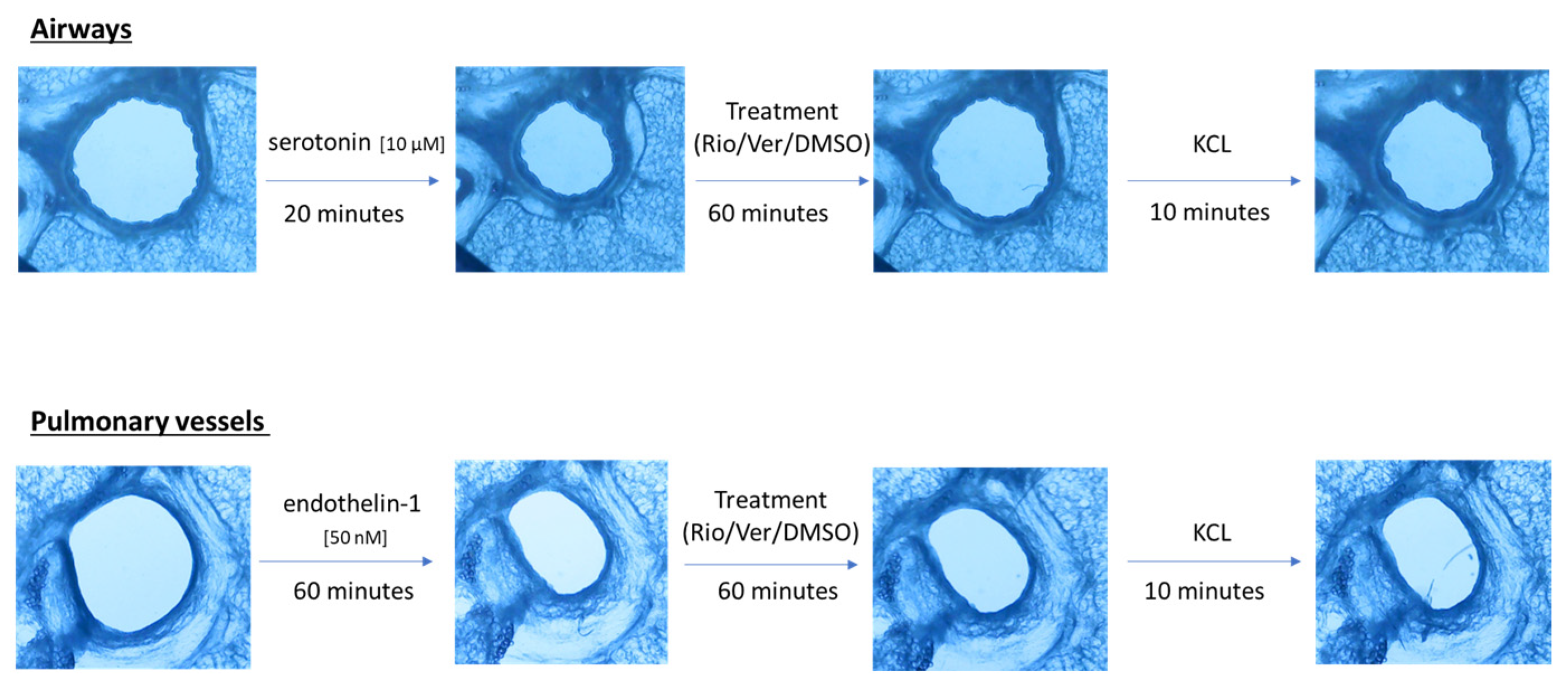
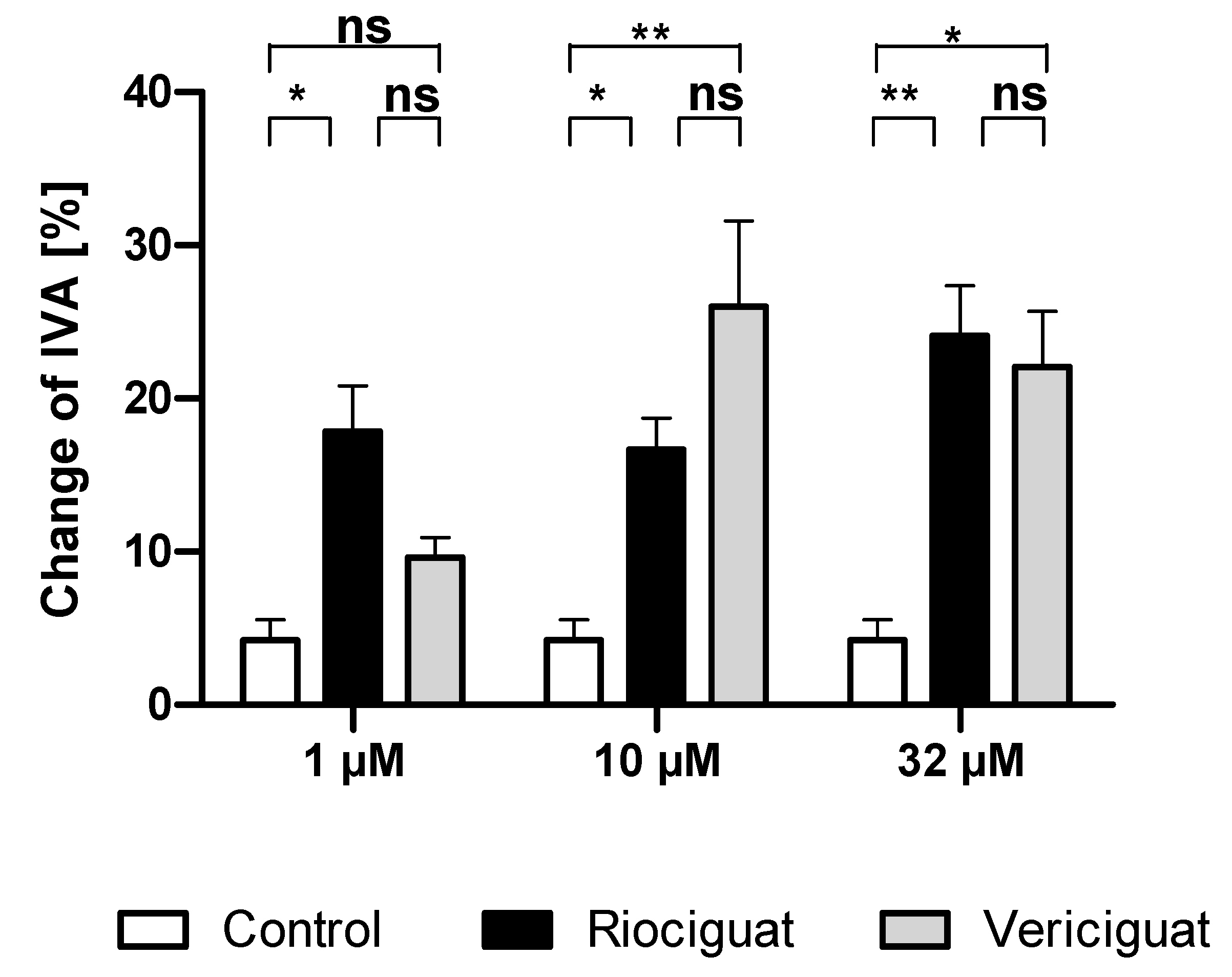
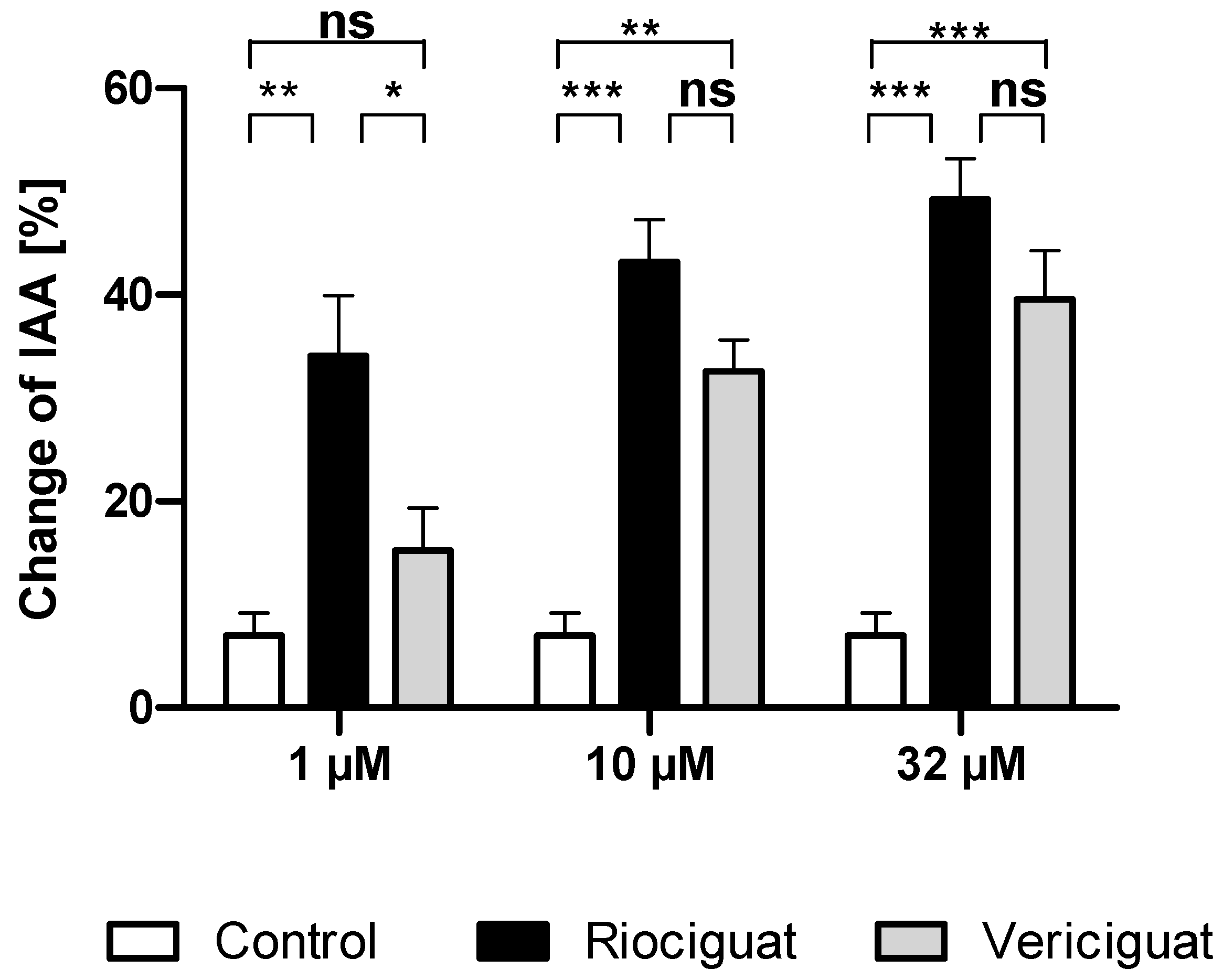
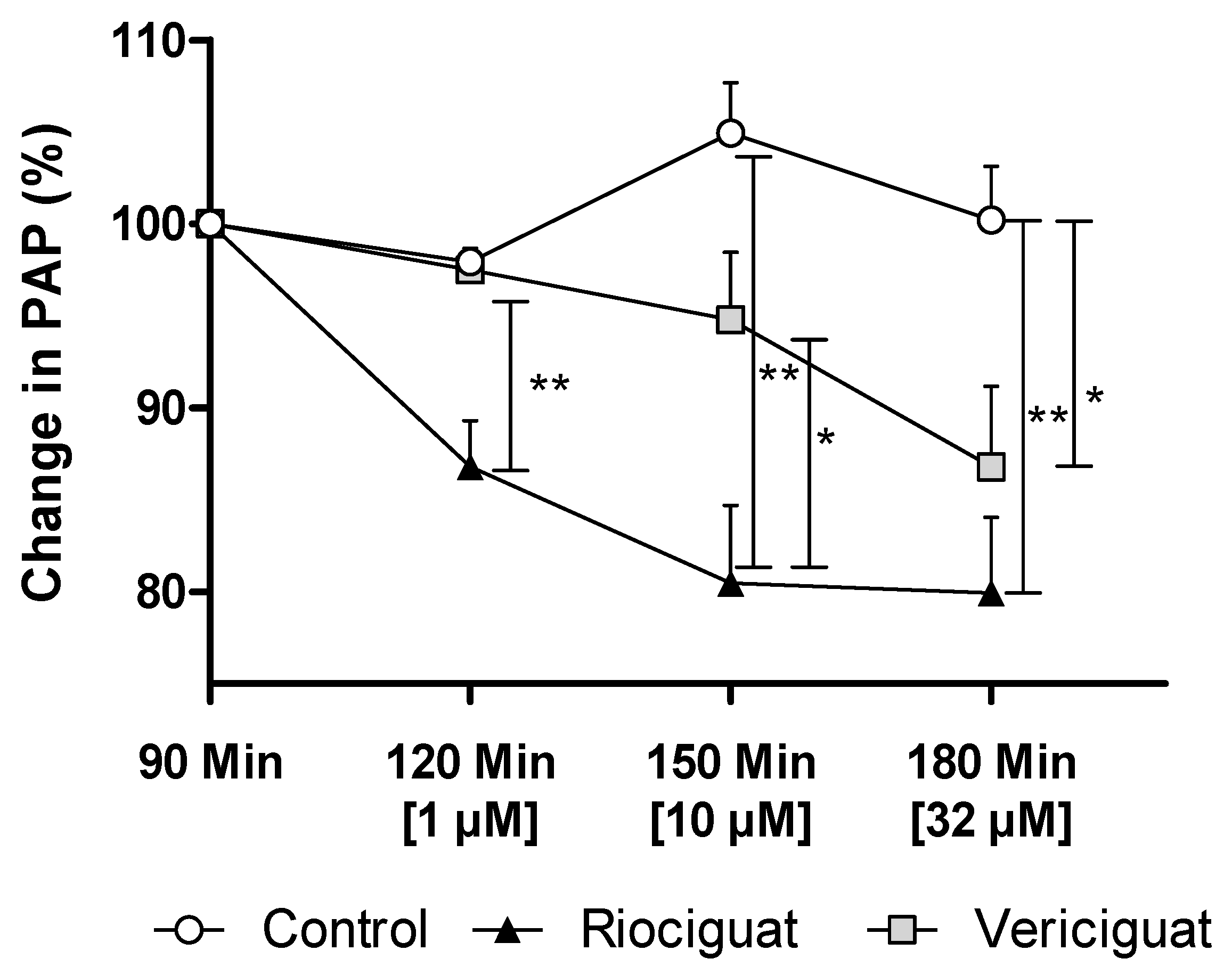

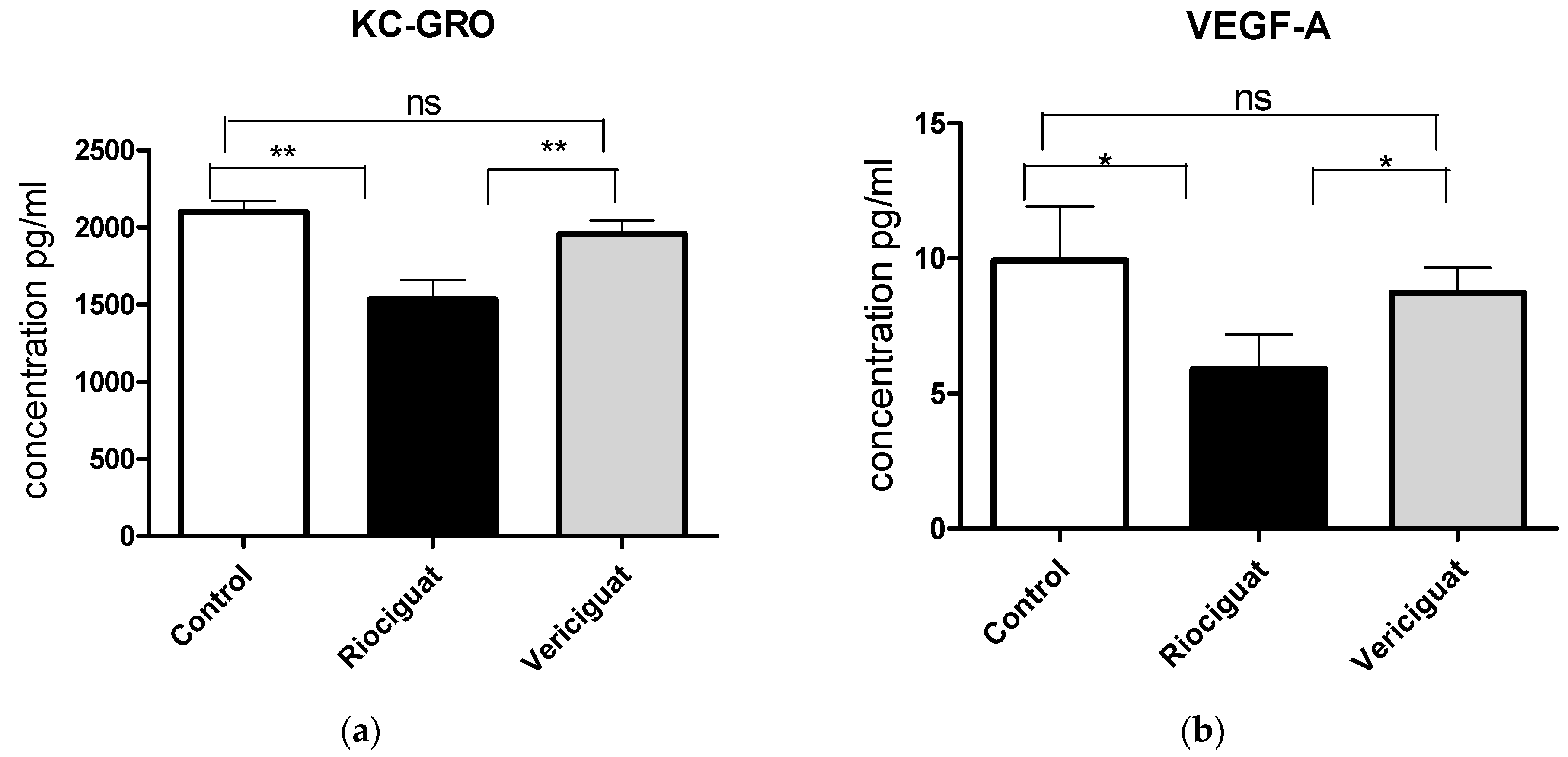

| Treatment | p-Value (vs. Control) | p-Value (vs. Vericiguat) |
|---|---|---|
| 1 µM Rio 10 µM Rio 32 µM Rio 1 µM Ver 10 µM Ver 32 µM Ver | * p = 0.041 * p = 0.049 ** p = 0.002 ns p = 0.79 ** p = 0.002 * p = 0.015 | ns p = 0.15 ns p = 0.27 ns p = 0.49 |
| Treatment | p-Value (vs. Control) | p-Value (vs. Vericiguat) |
|---|---|---|
| 1 µM Rio 10 µM Rio 32 µM Rio 1 µM Ver 10 µM Ver 32 µM Ver | ** p = 0.001 *** p < 0.0001 *** p < 0.0001 ns p = 0.25 ** p = 0.003 *** p = 0.0005 | * p = 0.045 ns p = 0.20 ns p = 0.36 |
| Treatment | p-Value (vs. Control) | p-Value (vs. Vericiguat) |
|---|---|---|
| 1 µM Rio 10 µM Rio 32 µM Rio 1 µM Ver 10 µM Ver 32 µM Ver | ** p = 0.007 ** p = 0.001 ** p = 0.0095 ns p = 0.79 ns p = 0.054 * p = 0.017 | ** p = 0.007 * p = 0.034 ns p = 0.51 |
| Treatment | p-Value (vs. Control) | p-Value (vs. Vericiguat) |
|---|---|---|
| 1 µM Rio 10 µM Rio 32 µM Rio 1 µM Ver 10 µM Ver 32 µM Ver | ns p = 0.11 ns p = 0.17 ns p = 0.33 * p = 0.049 * p = 0.039 * p = 0.018 | ns p = 0.29 ns p = 0.15 * p = 0.029 |
| Cytokine | Treatment | p-Value (vs. Control) | p-Value (vs. Vericiguat) |
|---|---|---|---|
| VEGF-A | riociguat | * p = 0.039 | * p = 0.048 |
| vericiguat | ns p = 0.52 | ||
| KC-GRO | riociguat | ** p = 0.0028 | ** p = 0.0066 |
| vericiguat | ns p = 0.51 | ||
| IL-6 | riociguat | * p = 0.03 | ns p = 0.71 |
| vericiguat | * p = 0.03 | ||
| IL-1ß | riociguat | * p = 0.037 | ns p = 0.49 |
| vericiguat | * p = 0.026 |
Disclaimer/Publisher’s Note: The statements, opinions and data contained in all publications are solely those of the individual author(s) and contributor(s) and not of MDPI and/or the editor(s). MDPI and/or the editor(s) disclaim responsibility for any injury to people or property resulting from any ideas, methods, instructions or products referred to in the content. |
© 2025 by the authors. Licensee MDPI, Basel, Switzerland. This article is an open access article distributed under the terms and conditions of the Creative Commons Attribution (CC BY) license (https://creativecommons.org/licenses/by/4.0/).
Share and Cite
Nubbemeyer, K.; Krabbe, J.; Böll, S.; Michely, A.; Kalverkamp, S.; Spillner, J.; Martin, C. Different Effects of Riociguat and Vericiguat on Pulmonary Vessels and Airways. Biomedicines 2025, 13, 856. https://doi.org/10.3390/biomedicines13040856
Nubbemeyer K, Krabbe J, Böll S, Michely A, Kalverkamp S, Spillner J, Martin C. Different Effects of Riociguat and Vericiguat on Pulmonary Vessels and Airways. Biomedicines. 2025; 13(4):856. https://doi.org/10.3390/biomedicines13040856
Chicago/Turabian StyleNubbemeyer, Katharina, Julia Krabbe, Svenja Böll, Anna Michely, Sebastian Kalverkamp, Jan Spillner, and Christian Martin. 2025. "Different Effects of Riociguat and Vericiguat on Pulmonary Vessels and Airways" Biomedicines 13, no. 4: 856. https://doi.org/10.3390/biomedicines13040856
APA StyleNubbemeyer, K., Krabbe, J., Böll, S., Michely, A., Kalverkamp, S., Spillner, J., & Martin, C. (2025). Different Effects of Riociguat and Vericiguat on Pulmonary Vessels and Airways. Biomedicines, 13(4), 856. https://doi.org/10.3390/biomedicines13040856








